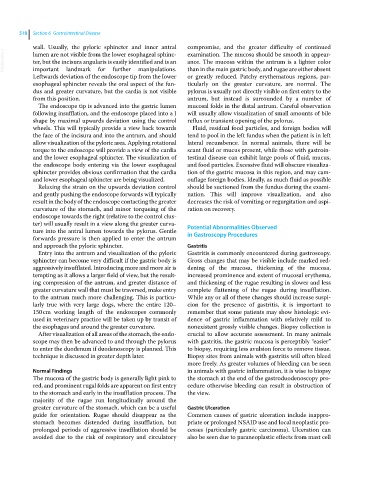Page 550 - Clinical Small Animal Internal Medicine
P. 550
518 Section 6 Gastrointestinal Disease
wall. Usually, the pyloric sphincter and inner antral compromise, and the greater difficulty of continued
VetBooks.ir lumen are not visible from the lower esophageal sphinc- examination. The mucosa should be smooth in appear-
ance. The mucosa within the antrum is a lighter color
ter, but the incisura angularis is easily identified and is an
important landmark for further manipulations.
or greatly reduced. Patchy erythematous regions, par-
Leftwards deviation of the endoscope tip from the lower than in the main gastric body, and rugae are either absent
esophageal sphincter reveals the oral aspect of the fun- ticularly on the greater curvature, are normal. The
dus and greater curvature, but the cardia is not visible pylorus is usually not directly visible on first entry to the
from this position. antrum, but instead is surrounded by a number of
The endoscope tip is advanced into the gastric lumen mucosal folds in the distal antrum. Careful observation
following insufflation, and the endoscope placed into a J will usually allow visualization of small amounts of bile
shape by maximal upwards deviation using the control reflux or transient opening of the pylorus.
wheels. This will typically provide a view back towards Fluid, residual food particles, and foreign bodies will
the face of the incisura and into the antrum, and should tend to pool in the left fundus when the patient is in left
allow visualization of the pyloric area. Applying rotational lateral recumbence. In normal animals, there will be
torque to the endoscope will provide a view of the cardia scant fluid or mucus present, while those with gastroin-
and the lower esophageal sphincter. The visualization of testinal disease can exhibit large pools of fluid, mucus,
the endoscope body entering via the lower esophageal and food particles. Excessive fluid will obscure visualiza-
sphincter provides obvious confirmation that the cardia tion of the gastric mucosa in this region, and may cam-
and lower esophageal sphincter are being visualized. ouflage foreign bodies. Ideally, as much fluid as possible
Relaxing the strain on the upwards deviation control should be suctioned from the fundus during the exami-
and gently pushing the endoscope forwards will typically nation. This will improve visualization, and also
result in the body of the endoscope contacting the greater decreases the risk of vomiting or regurgitation and aspi-
curvature of the stomach, and minor torqueing of the ration on recovery.
endoscope towards the right (relative to the control clus-
ter) will usually result in a view along the greater curva- Potential Abnormalities Observed
ture into the antral lumen towards the pylorus. Gentle in Gastroscopy Procedures
forwards pressure is then applied to enter the antrum
and approach the pyloric sphincter. Gastritis
Entry into the antrum and visualization of the pyloric Gastritis is commonly encountered during gastroscopy.
sphincter can become very difficult if the gastric body is Gross changes that may be visible include marked red-
aggressively insufflated. Introducing more and more air is dening of the mucosa, thickening of the mucosa,
tempting as it allows a larger field of view, but the result- increased prominence and extent of mucosal erythema,
ing compression of the antrum, and greater distance of and thickening of the rugae resulting in slower and less
greater curvature wall that must be traversed, make entry complete flattening of the rugae during insufflation.
to the antrum much more challenging. This is particu- While any or all of these changes should increase suspi-
larly true with very large dogs, where the entire 120– cion for the presence of gastritis, it is important to
150 cm working length of the endoscopes commonly remember that some patients may show histologic evi-
used in veterinary practice will be taken up by transit of dence of gastric inflammation with relatively mild to
the esophagus and around the greater curvature. nonexistent grossly visible changes. Biopsy collection is
After visualization of all areas of the stomach, the endo- crucial to allow accurate assessment. In many animals
scope may then be advanced to and through the pylorus with gastritis, the gastric mucosa is perceptibly “easier”
to enter the duodenum if duodenoscopy is planned. This to biopsy, requiring less avulsion force to remove tissue.
technique is discussed in greater depth later. Biopsy sites from animals with gastritis will often bleed
more freely. As greater volumes of bleeding can be seen
Normal Findings in animals with gastric inflammation, it is wise to biopsy
The mucosa of the gastric body is generally light pink to the stomach at the end of the gastroduodenoscopy pro-
red, and prominent rugal folds are apparent on first entry cedure otherwise bleeding can result in obstruction of
to the stomach and early in the insufflation process. The the view.
majority of the rugae run longitudinally around the
greater curvature of the stomach, which can be a useful Gastric Ulceration
guide for orientation. Rugae should disappear as the Common causes of gastric ulceration include inappro-
stomach becomes distended during insufflation, but priate or prolonged NSAID use and local neoplastic pro-
prolonged periods of aggressive insufflation should be cesses (particularly gastric carcinoma). Ulceration can
avoided due to the risk of respiratory and circulatory also be seen due to paraneoplastic effects from mast cell

